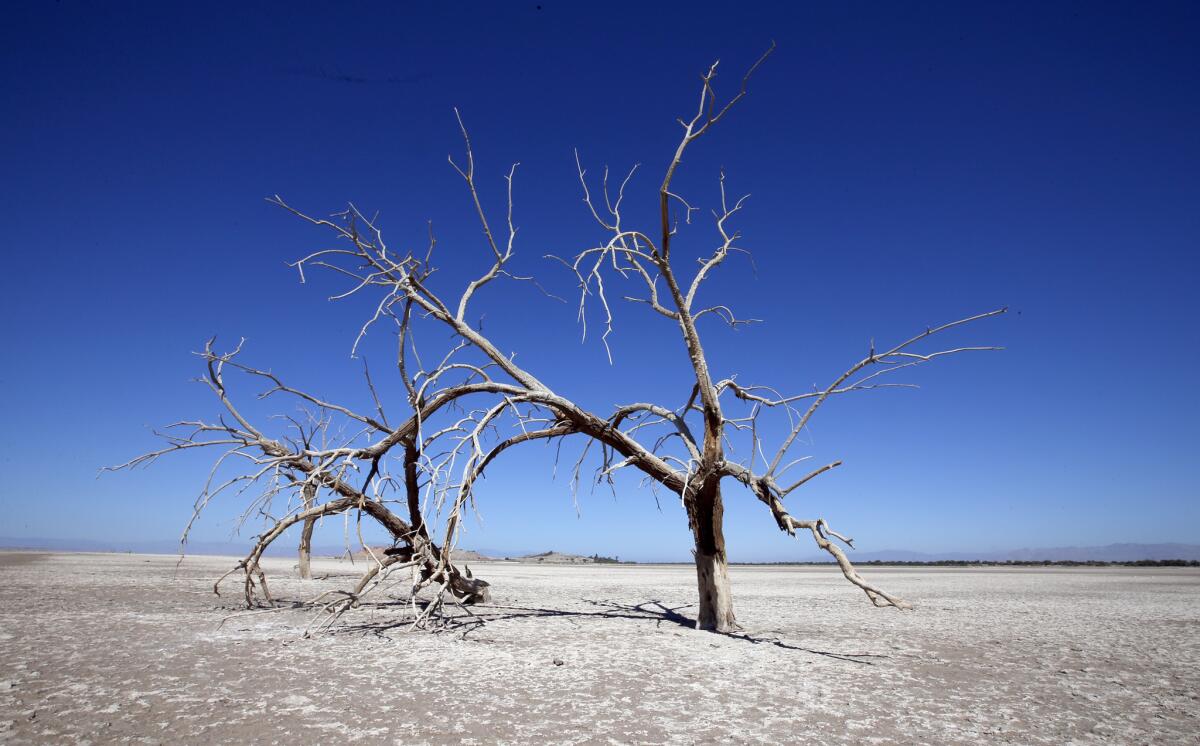Restoration work begins on part of Salton Sea

Once the Red Hill Bay part of the Salton Sea was covered with water. Now the sea bottom is open to the air, contributing to the region’s health problems.
- Share via
Officials last week took a step -- albeit a modest one -- toward restoring the beleaguered Salton Sea and possibly avoiding a predicted environmental and health catastrophe.
A ceremony Thursday attended by officeholders and others concerned with issues of water, wildlife and public health marked the beginning of a $3.5-million project to restore 420 acres of Red Hill Bay on the southeastern shore of the Salton Sea.
Once the bay was hip-deep with water. But in recent years, with the sea rapidly receding, the sea bottom, laden with pesticides and salt, has been exposed to the air, contributing to dust storms that have been blamed for the region’s high rate of asthma and other respiratory problems.
The 420 acres, part of the Sonny Bono National Wildlife Refuge, constitute only a small part of the newly exposed sea bottom at the Salton Sea.
But officials hope the Red Hill Bay project, slated for completion in early 2017, will signal that the Salton Sea is not a lost cause.
The Red Hill Bay project “is only the beginning,” said Rep. Raul Ruiz (D-Palm Desert).
“The decline of the Salton Sea poses immense health and economic risks to families and children across Southern California,” said Ruiz, a physician.
At 35 miles in length and 15 miles in width, the Salton Sea, which straddles Riverside and Imperial counties, is dependent on agricultural runoff for replenishment.
But a 45-year sales agreement signed in 2003 between the Imperial Irrigation District and the San Diego County Water Authority has required farmers to fallow some land to save water.
With less land being farmed, runoff has decreased. To offset the impact on the Salton Sea, the Imperial Irrigation District has been required to send water from the Colorado River directly into the sea.
That requirement lapses at the end of 2017. The Pacific Institute, an Oakland-based environmental think tank, has warned of an impending disaster to public health, property values, agricultural production, the environment and the recreation industry.
Already the wind has brought the rotten-egg smell of the Salton Sea westward to coastal communities.
Twice this year, officials and community activists from Imperial and Riverside counties have pleaded with the state water board in Sacramento to help avoid a “looming catastrophe” at the Salton Sea.
In 2003, to get the Imperial Irrigation District board to approve the sale of water to San Diego, the state promised to take responsibility for the Salton Sea’s problems. That promise has not been fulfilled.
Even with Colorado River water being sent directly into the Salton Sea, the sea has continued to shrink at a rate faster than predicted, Imperial Irrigation District General Manager Kevin Kelley told the state water board.
Last month, Gov. Jerry Brown signed a bill by Assemblyman Eduardo Garcia (D-Coachella) to require the state’s Natural Resources Agency to deliver a list of “shovel-ready” projects for the Salton Sea to the Legislature by March 31, including cost figures and timeline for completion.
Previous studies have put the cost of restoring the Salton Sea, or at least slowing its decline, in the billions of dollars.
The Salton Sea Authority has set a goal of restoring 12,000 acres of shoreline habitat in the next five years, and another 25,000 acres starting in 2020.
The decline of the Salton Sea has also had an impact on the fish population and migratory birds. The Red Hill Bay project, funded largely by the state, will “reflood” the acreage by diverting, in part, water from the nearby Alamo River.
Christian Schoneman, a project manager with the U.S. Fish and Wildlife Service, hopes that the project, by reducing “fugitive dust released during wind events,” will be a guide for other projects.
Although located in a remote part of the state, the Salton Sea is California’s “largest and most troubled body of water,” said Imperial Irrigation District officials attending the ceremony.
Twitter: @latsandiego
ALSO
Cold front could bring wind and light rain to L.A. area
Detectives say dead youth in East L.A. may have accidentally shot himself
Mystery light above L.A. brings fear, anger and questions
More to Read
Sign up for Essential California
The most important California stories and recommendations in your inbox every morning.
You may occasionally receive promotional content from the Los Angeles Times.













